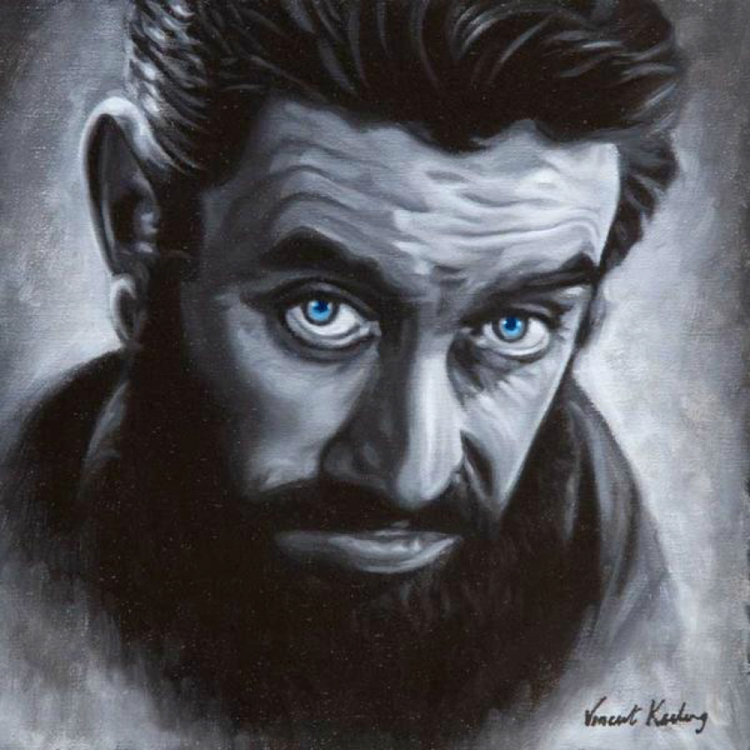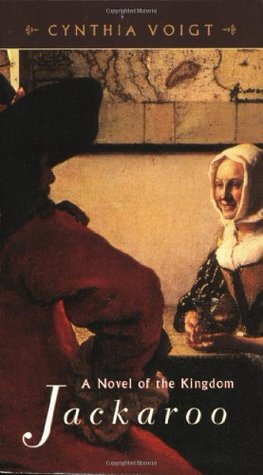Find five images in ‘The Americans’ where symbols are used. Explain what they are and how they function in the images.
See previous research about ‘The Americans’ (Merging genres, merging media)
‘The Americans’ is full of iconography suggesting in both explicit and implicit terms notions of American and identity and myth. During my research, I came across a list Frank made of things he might photograph in support of his application for the Guggenheim Fellowship which would provide the funding for him to complete ‘The Americans’:
“A town at night, a parking lot, a supermarket, a highway, the man who owns three cars and the man who owns none, the farmer and his children, a new house and a warped clapboard house, the dictation of taste, the dream of grandeur, advertising, neon lights, the faces of leaders, and the faces of followers, gas tanks and post offices and backyards…” (Dyer, 2005: 6)
Frank’s list gives some small insight into the subjects he was already preoccupied with before embarking on his road trip – the choices I make here are influenced by this, there are many images that I could have chosen and I have tried to stay away from those that have become iconic such as the cover image, ‘Trolley – New Orleans’ which, although it is undoubtedly a great image, seemingly encapsulating many of the tensions of 1950s America and embodying Frank’s concerns in a single image, much has already been written about it.
Rodeo – New York City

The cowboy is the ultimate icon of American myth, umbilically tied to notions of the pursuit of the American dream. At the time Frank made ‘The Americans’, this mythology was at its height, particularly demonstrated by Hollywood westerns. Undoubtedly, cowboys do really exist even today – the reality of their lives working the land is far removed from the image that springs to the mind of those who have no direct experience of their way of life. The man in this image, interestingly captioned by Frank as ‘Rodeo’, seems to typify the idea of the cowboy – even down to the relaxed pose lighting a cigarette. Everything else in the picture puts him out of place, however – he is in the city, not the country, rather than leaning against a fence he perches against a waste bin. This leads to the question of whether he is the genuine article, out of place, perhaps visiting the city – someone whose identity is so tied to the way they present themselves that they do not change their style for anyone. Or alternatively, this is not a real cowboy at all, but someone who has adopted the style as a fashion choice as an affectation. Although not made until 1969, I am reminded of Jon Voight’s character in ‘Midnight Cowboy’, a hustler who moved from Texas to New York to seek his fortune, naively thinking that his cowboy persona would support his attempts to become a gigolo. (“I ain’t a f’real cowboy. But I am one helluva stud!”) I wonder how much my knowledge of this later work influences my reading and attraction to this image, indeed, was it an influence on the filmmakers?
Yom Kippur – East River, New York City
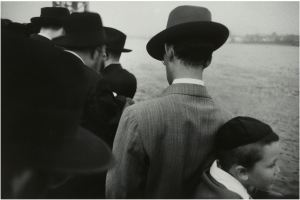
Religion is a theme prevalent through ‘The Americans’ and I find this image of Jewish men on a boat fascinating. What interests me here is the composition of the image, the frame is tightly packed and the shot apparently taken quickly as camera shake is evident. Apart from the boy in the foreground, few facial details are from the men in the frame. Even without the captioning of Yom Kippur, it is obvious the men are Jewish because of their appearance and clothing, particularly the hats worn by the men and the skull cap worn by the boy. Frank’s choice to caption the image with Yom Kippur could simply be factual, or it could be an explanation of why so many Jewish men are congregating – although there are only 7 people in the shot the suggestion is that there are many more outside the frame. The fact that no one looks directly at the camera seems important – is there a suggestion here about the desire for the Jewish community to remain separate from others or is this a point about anti-Semitism and that this separation is more necessity? Alternatively, this is simply a grabbed shot by Frank of a group that would not welcome their photographs taken.
Television studio – Burbank, California

The role of the media in American society is a theme Frank touches on throughout the book with images of television, cinema, newsstands and celebrity. This picture is like looking behind the magicians’ curtain with Frank choosing to emphasise the artifice inherent in the process of producing television. The focus is on a television screen on the right that seemingly shows the view of the woman on the left that is being filmed and will be broadcast. The presentation on the screen of sitting in a room is completely at odds with the set up we see, particularly the piles of wires that are on the floor behind the stage. The image as a whole can be read as a comment on how what the media presents is at odds with the real world, by extension, that images are deliberately faked giving the public a false and unobtainable ideal to strive for.
Movie premiere – Hollywood
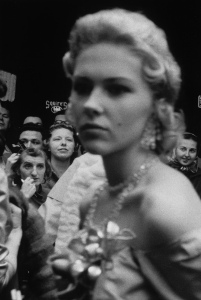
Celebrity culture is explored in this image, with the gulf between the bright and beautiful being directly emphasised with the seemingly glamorous woman in the foreground being shot out of focus with attention being placed on the normal people in the background who have come to watch. The three women who we can see clearly have intriguingly different expressions: the woman on the left seems in awe of what she is witnessing, there is a melancholy in her eyes that seems to recognise how separate she is from the starlet in front of her. The next woman in the centre seems much more self-assured but no less thoughtful, it is almost as if she is imaging herself on the red carpet – this aspirational ideal is central to the American myth that anyone can be anything. The woman on the right has a smile that suggests she is there for the spectacle and the entertainment, it is an ambivalent expression that is totally opposite to the first woman, for her viewing celebrity is akin to looking at animals in the zoo – a distracting pastime in which she is secure in her separateness from those she views.
Public park – Ann Abor, Michigan

In this image, two sets of couples, wearing swimsuits, enjoy intimate embraces on a summers day. Despite the rural setting, the background of the photograph is full of cars – the ultimate symbol of freedom and independence. The picture emphasises how youth culture is changing America, indeed disrupting the moral fibre of the nation. I imagine the clothing, or lack of, that the couples wear would have been provocative at the time, especially combined with the open display of public intimacy. Of course, my reading of this image is loaded with the knowledge of how youth culture exploded from the 1950s into the 1960s – indeed the view here is tame in comparison to what was to follow. The image succeeds in showing America on the cusp of this change, however. One of Frank’s themes is the tension he recognised in America in the late 1950s about how the nation was changing at a rapid pace, this image encapsulates that notion completely.
I note here a couple of comments made by Geoff Dyer in ‘The Ongoing Moment’ as they struck my attention and seem worthy of recording:
Butte Montana

The view from the window shows nothing special, in fact, the purpose of the photograph could be to confirm that the view does not warrant a second glance – because of this, it demands we return to it again and again. (Dyer, 2005: 216)
US 285, New Mexico

John Szarkowski described Frank’s work as a shift from documentary in the service of a social cause towards more personal ends. This can be illustrated by ‘US 285, New Mexico’ – a photograph that bears a startling similarity to Dorothea Lange’s ‘The Road West, New Mexico, 1938’. Whereas Lange’s picture can be read as a symbol of harsh economic necessity, distance and remoteness, Frank’s picture is the literal and metaphorical representation of his road trip, his artistic drive and the possibility of imminent encounters – there is no telling where the road will lead except the record of the journey will be Frank’s vision.
Read the introduction to ‘The Americans’ by Jack Kerouac. Find symbolic references that you can also identify in Robert Frank’s photographs – not necessarily the five images that you chose for this exercise.
Kerouac emphasises the poetry evident in Frank’s pictures and how “with the agility, mystery, genius, sadness and strange secrecy of a shadow photographed scenes that have never been seen before on film…with one hand he sucked a sad poem right out of America onto film, taking rank among the tragic poets of the world.”
I began this part of the exercise highlighting the symbolic references made in the essay and using these could probably discuss virtually every image in ‘The Americans’. Kerouac does not refer to the photographs he discusses explicitly, and although it is possible to identify many of his references easily, some are more difficult to identify but that seems fitting both of Kerouac’s prose style and the images themselves. Here are some quotes that caught my attention, they provide an interesting alternative caption to the images:
Bar – New York City
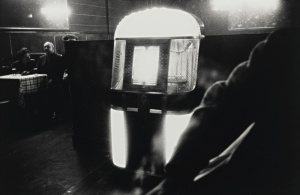
“you end up not knowing anymore whether a jukebox is sadder than a coffin”
Restaurant – U.S. 1 leaving Columbia, South Carolina
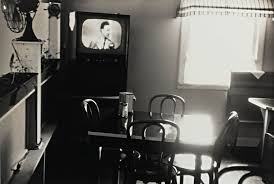
“the picture of a chair in some café with the sun coming in the window and setting on the chair in a holy halo I never thought could be caught on film much less described in its beautiful visual entirety in words.”
U.S. 91, leaving Blackfoot, Idaho
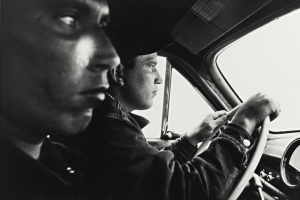
“the crazed voyageur of the lone automobile presses forth his eager insignificance in noseplates and licences into the vast promise of life.”
Covered car – Long Beach, California

“Car shrouded in fancy expensive designed tarpolian…to keep soots of no-soot Malibu from falling on new simonize job as owner who is a two-dollar-an-hour carpenter snoozes in house with wife and TV, all under palm trees for nothing in the cemeterial California night”
Men’s room, railway station – Memphis, Tennessee
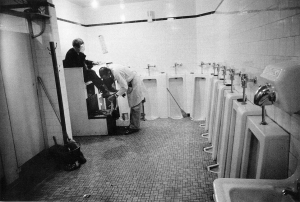
“the loneliest picture ever made, the urinals that women never see, the shoeshine going on in sad eternity-”
Elevator – Miami Beach

“little ole lonely elevator girl looking up sighing in an elevator full of blurred demons, what’s her name and address?”
Bibliography:
Dyer, G. (2005) The Ongoing Moment. London: Abacus.
Frank, R. (2008) The Americans. Gottingen: Steidl
Kerouac, J. (1956) Introduction to The Americans.
In: Frank, R. (2008) The Americans. Gottingen: Steidl
Advertisements Share this:

